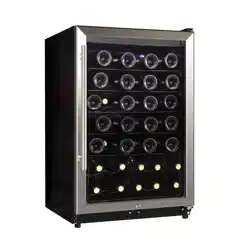Loading ...
Loading ...
Loading ...

Maintenance Service and Troubleshooting
Solution
Measure the high and low pressures with pressure gauges to see if they are
normal. If an abnormal sound comes from the compressor or the temperature is
too high, cut the discharge port open and operate the compressor. With a finger,
feel if there is pressure at the discharge port. In a normal compressor, its
discharge port is difficult to block with a finger.
5. Thick frost layer on evaporator
Analysis of Problem
If a direct cool refrigerator will be used for a prolonged period of time, be sure
to defrost its evaporator regularly; otherwise, the frost layer on the evaporator
tubing will become thick. Heat conduction will be severely affected if the whole
tubing is covered in ice, and the temperature in the refrigerator will not be able to
drop to the ideal range.
Solution
To defrost, first turn refrigerator off. Next, open refrigerator door to let in air or
use a fan to speed up airflow and defrosting process. To avoid damaging the
evaporator tubing, never strike frost layer with any iron tools or wooden sticks.
6. Refrigerating oil in evaporator tubing
Analysis of Problem
During refrigerating cycles, refrigerating oil residue may remain in the
evaporator tubing. However, if there is a considerable amount of refrigerating oil
in the evaporator, the heat conduction effect will be severely affected, which will
cause poor refrigeration effect.
Solution
It is sometimes difficult to determine if this issue is caused by refrigerating oil
residue in the evaporator tubing because it tends to be confused with other
problems. Generally, the cause can be determined by examining the frost on the
evaporator. If there is little to no frost covering the evaporator, this means the
deterioration of refrigerating effect is due to the accumulation of refrigerating oil
residue in the evaporator tubing, unless another problem have been discovered.
To remove refrigerating oil residue in the evaporator, disassemble the evaporator,
purge it thoroughly, and dry it. If it is difficult to disassemble, charge refrigerant
from the evaporator inlet several times to wash it. Then, purge and dry it with
nitrogen.
7. Obstructed flow in refrigerating system
Analysis of Problem
If the refrigerating system is not cleaned thoroughly, some of the filter screen
meshes can become clogged with dirt that accumulated after a long period of
use. This causes a decrease in flow rate and a poor refrigerating effect.
Malfunctions caused by this abnormal occurrence are:
19
Loading ...
Loading ...
Loading ...
